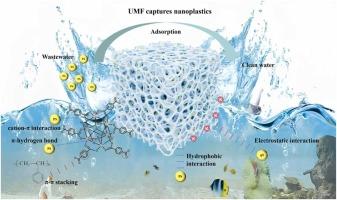mof基复合材料通过多种驱动力对复杂水体系中聚苯乙烯纳米塑料的高效去除
IF 11.3
1区 环境科学与生态学
Q1 ENGINEERING, ENVIRONMENTAL
引用次数: 0
摘要
微纳米塑料作为广泛存在于水生环境中的新兴污染物,引起了全球环境和生物安全问题。传统吸附剂对MPs/NPs的高效去除面临着选择性差、循环稳定性低等挑战。本研究开发了原位合成策略,将UIO-66与三聚氰胺泡沫(MF)整合,成功构建了具有高吸附容量和优异结构稳定性的UIO-66/MF (UMF)复合材料。结果表明,UMF对PS NPs的吸附在300 min内达到平衡,吸附量为65.5 mg/g。此外,在较宽的pH范围(3-10)和复杂的水溶液条件下,UMF的吸附效率分别保持在93%和82%以上。机理分析表明,吸附过程涉及多种协同作用,包括疏水相互作用、静电相互作用、π-π堆积、氢键和阳离子-π相互作用。此外,我们还系统地揭示了导致自来水和河水中吸附效率下降的因素。值得注意的是,UMF具有出色的可重复使用性,在25次循环后仍保持了81%以上的去除效率。UMF有效地解决了mof粉末不稳定性和回收困难的挑战,实现了经济性,可持续性和实用性之间的平衡。该复合材料为修复水环境中MPs/NPs污染提供了一种很有前景的解决方案。本文章由计算机程序翻译,如有差异,请以英文原文为准。

Efficient removal of polystyrene nanoplastics from complex water system through multiple driving forces with MOF-based composite
As emerging contaminants widely present in aquatic environments, micro/nano plastics (MPs/NPs) pose global environmental and biosafety concerns. The efficient removal of MPs/NPs faces challenges such as poor selectivity and low cyclic stability of traditional adsorbents. This study developed an in-situ synthesis strategy to integrate UIO-66 with melamine foam (MF), successfully constructing UIO-66/MF (UMF) composite that combined high adsorption capacity with excellent structural stability. The results showed that UMF achieved adsorption equilibrium for PS NPs within 300 min, with an adsorption capacity of 65.5 mg/g. Moreover, UMF maintained over 93% and 82% adsorption efficiency in a broad pH range (3-10) and under complex aqueous conditions, respectively. Mechanistic analysis revealed that multiple synergistic interactions were involved in the adsorption process, including hydrophobic interactions, electrostatic interactions, π-π stacking, hydrogen bonding and cation-π interactions. Furthermore, we systematically disclosed the factors which led to the decreased adsorption efficiency in tap water and river water. Notably, UMF exhibited exceptional reusability, retaining higher than 81% removal efficiency after 25 cycles. UMF effectively addresses the challenges of MOFs powders instability and recycling difficulties, achieving a balance between economy, sustainability, and practicality. This composite provides a promising solution for remediating MPs/NPs pollution in aqueous environments.
求助全文
通过发布文献求助,成功后即可免费获取论文全文。
去求助
来源期刊

Journal of Hazardous Materials
工程技术-工程:环境
CiteScore
25.40
自引率
5.90%
发文量
3059
审稿时长
58 days
期刊介绍:
The Journal of Hazardous Materials serves as a global platform for promoting cutting-edge research in the field of Environmental Science and Engineering. Our publication features a wide range of articles, including full-length research papers, review articles, and perspectives, with the aim of enhancing our understanding of the dangers and risks associated with various materials concerning public health and the environment. It is important to note that the term "environmental contaminants" refers specifically to substances that pose hazardous effects through contamination, while excluding those that do not have such impacts on the environment or human health. Moreover, we emphasize the distinction between wastes and hazardous materials in order to provide further clarity on the scope of the journal. We have a keen interest in exploring specific compounds and microbial agents that have adverse effects on the environment.
 求助内容:
求助内容: 应助结果提醒方式:
应助结果提醒方式:


